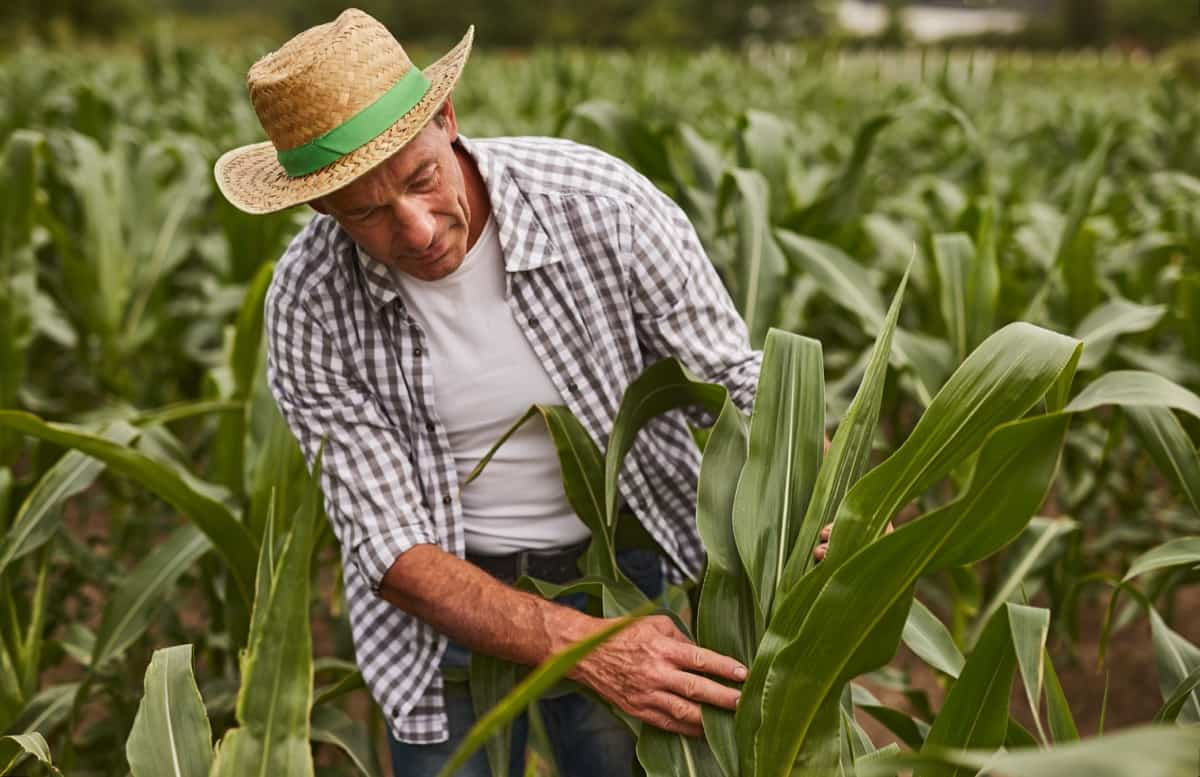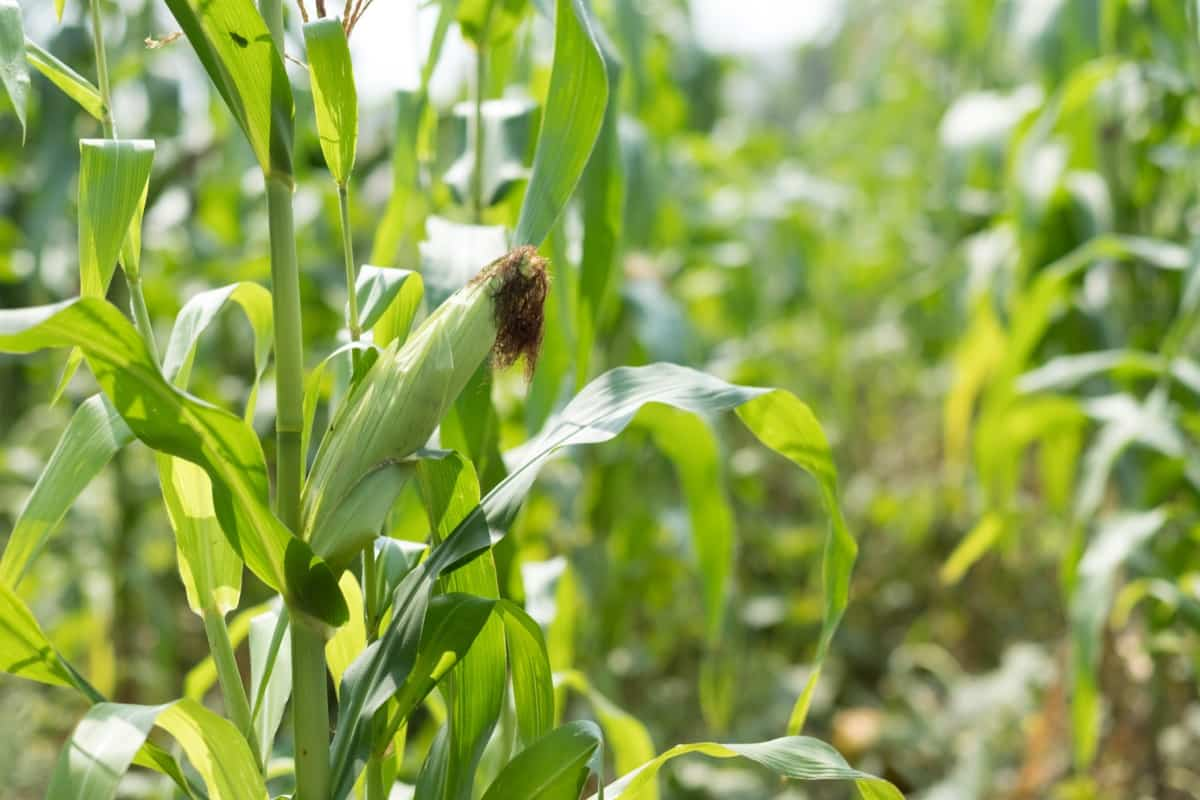Brown spots on corn plant leaves can be a sign of various underlying issues. Identifying the causes and implementing effective organic home remedies can help treat and prevent further damage to your corn plants. This article will explore the causes of brown spots on corn plant leaves and learn how to treat brown spots on corn plant leaves naturally.

How to Treat Brown Spots on Corn Plant Leaves Naturally
Fungal Infections on Corn Plant Leaves
Damping off
Damping off in corn is a common fungal disease affecting young seedlings. It is caused by several different types of fungi, including Pythium, Rhizoctonia, and Fusarium. The disease typically occurs in cool, wet conditions and can lead to severe damage and loss of the crop. To prevent this, sow injury-free seeds of resistant varieties. Follow good cultural practices, e.g., plant in warm, moist soil; prepare the seed bed properly.
Root Rot
Root rot is a most common problem that can affect corn plants, causing significant damage to their root systems and overall health. It is caused by various fungal pathogens that thrive in damp and poorly drained soil conditions. To treat this, dilute neem oil according to the package instructions and spray it onto the affected plants, focusing on the roots and surrounding soil.
Stalk Rots
Various fungal pathogens, including Fusarium, Gibberella, and Diplodia, cause it. Stalk rot typically occurs during warm and humid weather conditions, which create a favorable environment for fungal growth and infection. Some beneficial microorganisms, such as Trichoderma spp., have been found to suppress fungal pathogens. Apply biocontrol agents as directed to help protect corn plants from stalk rot.
Nutrient Deficiencies Causing Brown Spots on Corn Leaves
One common symptom of nutrient deficiencies in corn is the appearance of brown spots on the leaves. To address nutrient deficiencies causing brown spots on corn leaves, it is crucial to identify the specific nutrient lacking and take appropriate corrective measures. This can be achieved by conducting soil tests to determine nutrient levels and using fertilizers or soil amendments to replenish the deficient nutrients. Proper crop rotation, crop residue management, and maintaining optimal soil pH levels can also help prevent nutrient deficiencies and promote healthy corn growth.
Environmental Stress and Brown Spots on Corn Leaves
Temperature Extremes
Both excessively high and low temperatures can trigger stress in corn plants. Exposure to extreme heat or cold can disrupt physiological processes, developing brown spots on leaves. In extremely hot climates, providing shade to corn plants during peak sunlight hours can help protect them from excessive heat stress.
Water Stress
Insufficient or excessive watering can result in water stress, adversely affecting corn plants. Drought conditions can cause leaves to wither and develop brown spots while overwatering can lead to root rot, impairing nutrient uptake and causing leaf discoloration. Maintaining an optimal soil moisture level through regular and appropriate irrigation practices can help prevent both drought stress and overwatering.
In case you missed it: Fertilizer Requirements and Recommendations for Corn: Management Practices for Optimal Yield

Nutrient Deficiencies
Inadequate availability of essential nutrients like nitrogen, phosphorus, or potassium can weaken corn plants, making them more susceptible to stress. Nutrient deficiencies can manifest as brown spots on leaves, indicating the plant’s struggle to thrive. Ensuring a balanced supply of essential nutrients through proper fertilization practices can enhance plant health and resilience to stress.
Organic Fungicides for Treating Brown Spots on Corn Leaves
Organic fungicides offer a safe and environmentally friendly option for treating brown spots on corn leaves. Neem oil, copper-based fungicides, garlic extract, and baking soda are among the commonly used organic fungicides that can effectively control fungal infections. Farmers and gardeners can protect their corn plants and ensure a healthy and productive harvest by incorporating these organic treatments into a comprehensive management strategy.
Companion Planting for Preventing Brown Spots on Corn Leaves
Companion planting is an effective natural way to prevent brown spots on corn leaves. By strategically planting companion plants such as marigolds, beans, squash, sunflowers, and cucumbers, corn farmers can create a healthy and balanced ecosystem that promotes the growth and vitality of corn plants. Implementing companion plantings can help prevent brown spots on corn leaves, ensuring a successful corn harvest.
Proper Crop Rotation to Prevent Brown Spots on Corn Leaves
Implementing a proper crop rotation plan is essential for preventing brown spots on corn leaves. By including non-host crops, extending the rotation cycle, and following good cultural practices, farmers can effectively reduce disease pressure and ensure the health and productivity of their corn crop. Proper crop rotation helps prevent brown spots and contributes to overall soil health and sustainable agriculture practices.
Natural Remedies for Specific Fungal Infections on Corn Leaves
Natural remedies such as neem oil, baking soda, garlic extract, copper-based fungicides, and cultural practices can help combat specific fungal infections on corn leaves. While natural remedies can effectively manage fungal infections on corn leaves, prevention is always better than cure. Maintaining overall plant health through proper nutrition, soil management, and regular monitoring can significantly reduce the risk of fungal infections. Additionally, selecting disease-resistant corn varieties can provide an added layer of protection against fungal pathogens.
Organic Soil Amendments to Prevent Brown Spots on Corn Leaves
Organic soil amendments can play a crucial role in preventing brown spots on corn leaves. By incorporating compost, well-rotted manure, compost tea, and organic matter into the soil, corn plants can be provided with the necessary nutrients, improved soil structure, and enhanced disease resistance. These practices contribute to the overall health and vigor of the corn plants, reducing the occurrence of brown spots on the leaves and promoting successful corn cultivation.
Proper Pruning Techniques for Managing Brown Spots on Corn Leaves
Begin pruning by focusing on leaves with significant brown spots or signs of severe damage. Remove these leaves at their base, making clean cuts to minimize plant stress. It is essential to avoid tearing or damaging the healthy parts of the plant while pruning. After removing the affected leaves, place them directly into a container or bag for disposal.
This prevents the potential spread of diseases or pests to other parts of the plant or nearby plants. Between pruning different plants or affected areas, it is important to clean and disinfect your tools. Wipe the pruning shears or scissors with a disinfectant or soak them in rubbing alcohol for a few minutes. This step reduces the risk of spreading diseases from one plant to another.
Maintaining Proper Air Circulation to Prevent Brown Spots on Corn Leaves
Plant Spacing
Proper spacing between corn plants and rows facilitates air movement. The recommended spacing between plants varies depending on the corn variety and soil fertility. By following appropriate spacing guidelines, farmers can ensure adequate air circulation and minimize the risk of brown spots on corn leaves.
In case you missed it: Frequently Asked Questions About Growing Baby Corn from Seed to Harvest

Pruning and Thinning
Regular pruning and thinning of corn plants promote better air circulation by reducing overcrowding and excessive foliage growth. Farmers should remove any damaged or diseased leaves and thin out the plants to maintain an optimal canopy structure. This practice allows air to flow freely through the plants, minimizing the chances of brown spot development.
Conclusion
By implementing these natural remedies and taking preventive measures, you can effectively treat and prevent brown spots on corn plant leaves. Regular monitoring and early intervention are essential in maintaining the health and productivity of your corn plants.
- Feed Your Flock for Less: Top 10 Tips to Save on Chicken Feed
- Ultimate Guide to Ossabaw Island Hog: Breeding, Raising, Diet, and Care
- Hatching Answers: The Top 10 Reasons Your Chickens Aren’t Laying Eggs
- Eggs and Economics: Breaking Down the Cost of Raising Backyard Chickens
- Defend Your Greens: Proven Methods to Keep Iguanas Out of Your Garden
- Ultimate Guide to Cinnamon Queen Chicken: A Comprehensive Guide for Beginners
- Ultimate Guide to California Tan Chicken: Breeding, Raising, Diet, Egg-Production and Care
- Ultimate Guide to Marsh Daisy Chicken: Breeding, Raising, Diet, and Care
- 10 Types of Chicken Farming Businesses You Can Start for Profits